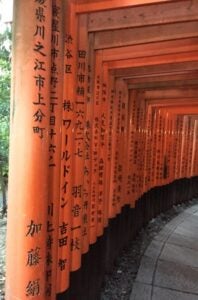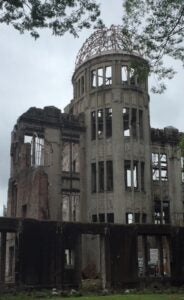July 8, 2016
Bioethics and Comparative Healthcare in Japan
 By Taylor Leposa, junior EC Scholar
By Taylor Leposa, junior EC Scholar
Studying bioethics and comparative healthcare in Japan was an incredible experience. The course focused on exploring the similarities and differences between the Japanese and American healthcare systems, as well as discussing the implications of various bioethical issues. The Japanese have one of the longest average life spans out of every country. Though America spends more money per person on healthcare, the populations expected life span is significantly shorter.
This course explored the advantages of having one single payer for services and a collectivist society when it comes to healthcare. Because of the collectivist nature of the country, many people views on ethical dilemmas that are very similar. The country as a whole is not as largely opposed to the option of abortion as some groups in America, people are hesitant to take part in organ transplantation or donation, and there is no apparent opposition to government funded research on adult stem cells.
When we dug deeper into these viewpoints, we largely found that we could not get a straight answer from the experts. It seems that most people could not explain their position on these dilemmas, and that societal norms were the main influencer.
We also discussed at length the impact that World War II had on the current society and  healthcare system. One factor that significantly impacted healthcare was Unit 731, a Japanese medical research unit in the military that performed extensive and inhuman experiments out of China on foreigners and prisoners of war. Research was done on the impact of frostbite, syphilis, and many other conditions. We discussed the implications of the American response to these scientists at the end of the war, which was to largely cover it up because the information was useful. We talked further about the atomic bombs, and the lasting effects from them being dropped. My visit to Hiroshima is pictured right. The Atomic Bomb Dome is one of the only buildings standing today to have survived the blast.
healthcare system. One factor that significantly impacted healthcare was Unit 731, a Japanese medical research unit in the military that performed extensive and inhuman experiments out of China on foreigners and prisoners of war. Research was done on the impact of frostbite, syphilis, and many other conditions. We discussed the implications of the American response to these scientists at the end of the war, which was to largely cover it up because the information was useful. We talked further about the atomic bombs, and the lasting effects from them being dropped. My visit to Hiroshima is pictured right. The Atomic Bomb Dome is one of the only buildings standing today to have survived the blast.
 As far as our cultural visit, we got to see many Shinto Shrines and Buddhist Temples. Many of the shrines are rather simple, and all are marked at the entrance by a Torii gate. The Shrine pictured above is in Kyoto and is known as the Thousand Gate Shrine. Businesses and families make monetary donations to have their name on a new gate, which is placed in along a trail up a mountain leading to a shrine worshipping their god of a good rice harvest. The temples had sometimes many rooms with tatami on the floor, and often had beautiful gardens. The bamboo forest pictured above is at one of the temples in Kyoto. The Zen Buddhism temples also have zen gardens, in which patterns are raked through rocks. The group also got to take part in a zen meditation session led by one of the monks.
As far as our cultural visit, we got to see many Shinto Shrines and Buddhist Temples. Many of the shrines are rather simple, and all are marked at the entrance by a Torii gate. The Shrine pictured above is in Kyoto and is known as the Thousand Gate Shrine. Businesses and families make monetary donations to have their name on a new gate, which is placed in along a trail up a mountain leading to a shrine worshipping their god of a good rice harvest. The temples had sometimes many rooms with tatami on the floor, and often had beautiful gardens. The bamboo forest pictured above is at one of the temples in Kyoto. The Zen Buddhism temples also have zen gardens, in which patterns are raked through rocks. The group also got to take part in a zen meditation session led by one of the monks.
Overall, the experience was wonderful and educational. It makes one realize how large the world is to experience another culture on a first-hand basis.
